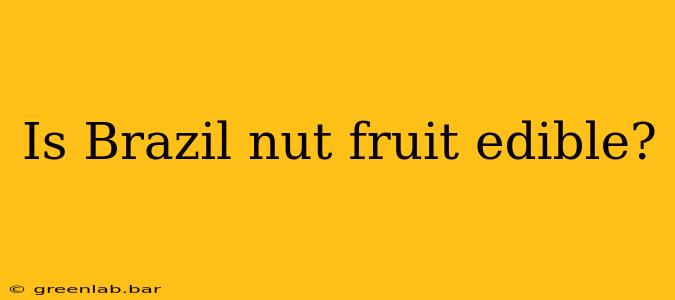The Brazil nut, that iconic, hefty seed we crack open for its rich, buttery flavor, is often mistakenly referred to as a nut. But the truth is more fascinating. The Brazil nut isn't a nut at all; it's a seed, and it's encased within a large, woody fruit. So, the question isn't just whether the seed is edible, but whether the entire fruit is consumable. The answer is nuanced.
Understanding the Brazil Nut Fruit
The Brazil nut tree (Bertholletia excelsa) produces a large, spherical fruit, roughly the size of a grapefruit. This fruit is a woody capsule, incredibly hard and resistant to damage. Inside this tough exterior lies the treasure: dozens of triangular, dark brown Brazil nuts nestled together.
So, is the fruit itself edible? Not in the way you might expect. The hard, woody shell is inedible and virtually impossible to crack open without specialized tools. While not toxic, it's simply too tough and fibrous for human consumption.
The Edible Part: The Seeds (Brazil Nuts)
The real prize within the Brazil nut fruit lies within its seeds—those delicious, nutritious Brazil nuts we all know and love. These are rich in healthy fats, protein, selenium, and other essential minerals. It's the seeds, not the fruit, that are consumed.
Nutritional Powerhouse: Why We Eat Brazil Nuts
Brazil nuts are renowned for their exceptional nutritional profile. They're a fantastic source of:
- Selenium: A powerful antioxidant crucial for thyroid function and overall health. Just one or two Brazil nuts can often provide the recommended daily intake of selenium.
- Healthy Fats: Primarily monounsaturated and polyunsaturated fats, beneficial for heart health.
- Protein: A good source of plant-based protein.
- Fiber: Contributes to digestive health.
- Magnesium: Essential for numerous bodily functions.
- Vitamin E: Another important antioxidant.
Harvesting Brazil Nuts: A Natural Process
Harvesting Brazil nuts is a unique process. The fruits fall naturally from the tree, often assisted by agoutis, a rodent that plays a vital role in seed dispersal. Humans collect these fallen fruits, carefully cracking open the hard shells to extract the precious Brazil nuts inside. This natural harvesting method underscores the importance of sustainable practices in preserving this valuable resource.
Conclusion: The Fruit's Role
While the Brazil nut fruit itself isn't directly edible due to its hard, woody shell, it plays a crucial role in the life cycle of the tree and the harvesting of the delicious and nutritious seeds within. So, while you won't be eating the fruit, understanding its importance in the context of this Amazonian giant helps appreciate the whole process of obtaining this highly prized, energy-dense food source.

